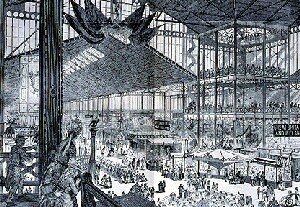|
1 2 3 4 |
 Copyright: McCabe 1876, T. 2 |
Numerous inventions could be discovered under the roof of the main building. The 30,800 exhibitors presented, for instance, the first sewing machines, the first practicable typewriter and Alexander Graham Bell’s telephone. The USA were to establish themselves impressively as one of the leading industrial powers before the world exhibition’s international forum. More than a third of the main building, and over 80 percent of the Engine Hall were taken up by the host’s exhibits. Amongst the agricultural machines and products, the US displayed important developments, too. In their reports from Philadelphia, the other nations’ journalists were impressed. The host’s triumph turned out even greater, since few of the other countries had supplied their exhibition contributions with outstanding objects.
In Germany, serious controversy broke out over the quality of her contribution. Franz Reuleaux’s letters, who sat on the jury in Philadelphia as director of the Berlin Institute of Industry, included a scathing judgement on German industrial products, which he described as “cheap and bad”. This lead to attacks against his person. His French-sounding name animated his opponents to accuse him of betraying Germany and wanting to cause her harm. Indeed, his argumentation was not always free of errors (mistakes were found in his economic statistics), and not all of the branches of industry had presented themselves as badly as Reuleaux had claimed. Nonetheless, his remarks helped to rouse the German industry to work on improving the quality of its products. Reuleaux’s commentaries and his subsequent activities to secure German industrial standards were instrumental in bringing about a renewal of economic laws and ultimately lead to the desired quality improvements in the 1880s and 1890s. Only since those years has the label “Made in Germany”, which hitherto had been meant as a warning, become a sign of high quality.
All the world exposition’s exhibits had been classified by a complex scheme. Seven main categories (mining and metallurgy, arts and crafts, education and science, art, machines, agriculture and landscape architecture) were subdivided twice each. This system was later extended to all human activity by Dewey’s decimal system, and today serves the majority of American libraries as its cataloguing foundation.
Next to the ballet of steam engines, the art exhibition in Memorial Hall was particularly well received. This was the first proper international art presentation in the US, and included not only paintings and sculptures but also photography on an equal footing. Of particular interest was also the Women’s Pavilion, which was installed and run by the Women’s Centennial Executive Committee consisting entirely of women. A steam engine with six horsepower developed by Emma Allison drove the looms and spinning-frames in the pavilion. Contemporary commentators admiringly highlighted the elegance and precision of the exhibited embroideries and textiles.
In spite of the 9 million visitors who were expected to come to the Centennial Exhibition by 10 November, it was a financial failure. The deficit measured $1.9 million, and since the government demanded its loan of $1.5 million back, the shareholders had to bear to whole loss. On the other hand, the US’s improvement in image was considerable, and since some important business contracts were also signed in Philadelphia, most Americans drew a positive conclusion from their first major world exhibition.
| Year: 1876 | City: Philadelphia | Country: USA |
| Duration: 10th May - 10th November 1876 | ||